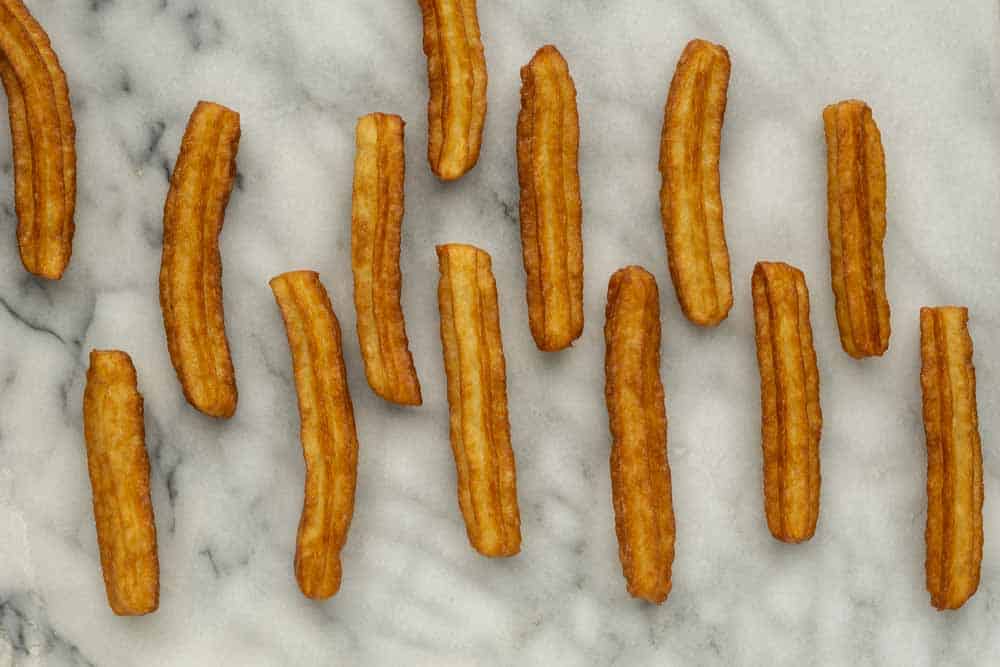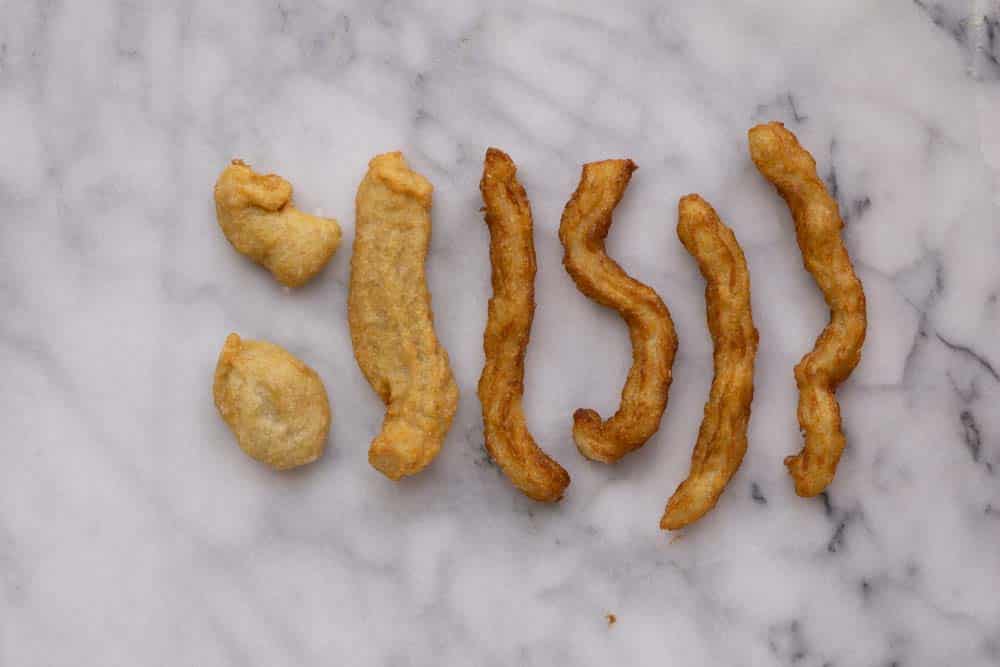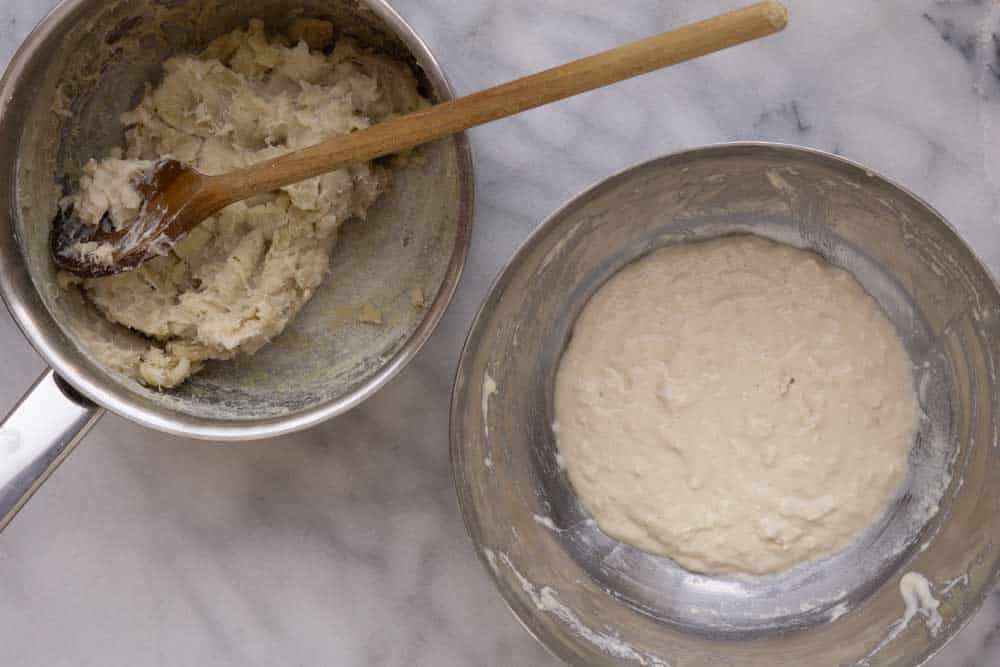Learn the science behind:

How Churros Keep Their Shape
Sometimes, you don’t realize how tricky something may be, until you try it yourself. That happened to me when trying to make churros. Somehow, I couldn’t get churros with that nice ridged, shape. They puffed up and lost their pointiness. What was going wrong?
Turns out, you should not skip cooking the flour and water into a thick paste before attempting to deep-fry. Once I got that under control, churros came out looking better every next time.
Churros may swell during deep-frying
The first attempt at making churros resulted in thick churros with barely any visible ridges. As soon as the churros batter touched the hot oil in which they were fried, the churros expanded and changed shape. In order for the churros to keep their shape during frying, it was clear something needed to change.
So, we started to analyze what happens when deep frying churros. When you add a batter to hot oil:
- The temperature of that batter increases rapidly, especially on the outside;
- As a result, water within the batter evaporates and expands;
- Starch gelatinizes and swells by absorbing water from the batter.
We needed to make sure that the rapid temperature increase would not result in a change of the shape of the churros batter when it hit the oil. It seemed like the last bullet point would provide most opportunities.

What churros & hot water crust pastry have in common
Turns out, people all over the world have been finding ways to control and manage the behavior of wheat flour as it’s used to make a wide variety of dishes. Various noodle types, hot water crust pastry, light soft donuts, they all use a similar method to do so: the flour is cooked with some hot water before it’s used in its final product!

The batter on the left needed extra water to be flexible enough to be used for churros.
Gelatinizing starch swells
A major component of flour is starch. Starch is a large carbohydrate. In raw flour, it’s ‘packed’ away in tiny granules, spread throughout the flour. When heating starch, it aborbs more and more water, causing it to swell. At some point, those granules break and individual starch molecules are released, which can absorb even more water. This process is commonly refered to as gelatinization.
It’s a crucial process to happen for many breads and pastries. It gives structure and firmness. But, in the case of churros, it can also cause the batter to swell and change shape. In the case of churros, we do not want this to happen. Ideally, the raw churro dough has more or less the same shape as the cooked churro dough!
Pregelatinization reduces swelling
To overcome this process, it’s a matter of ‘swelling’ the starch, before it’s added to the hot oil. This is why, to make churros, you are generally instructed to mix flour and water and continue stirring it while cooking the mixture. This causes the mixture to thicken and all the water to be absorbed.

Controlling the consistency
Pre-cooking the flour is a crucial first step to making beautiful churros, but, it’s not all. To make a good churro, the batter should be:
- Thick enough to hold onto its shape for at least several seconds, if not minutes.
- Thin enough for it to be piped through a piping bag or pushed through a churrera (the sturdy tool used to make churros).
It needs to be pressed through a narrow opening
To shape a churro into that ridged shape, you need to push it through some sort of star-shaped opening. Whenever pushing something through a narrow-ish opening, you need to use a little extra pressure to push it through.
Professionals tend to use a churrera to make churros. These devices are made of stainless steel and can exert a lot more pressure on a churro dough than a plastic piping bag can. As a result, professionals can use quite a firm batter to make churros, helping the batter to maintain its shape.
If you’re making churros at home, you’re likely stuck with a plastic piping bag. These can handle only so much pressure. If your churros dough is too firm, it will break (see below for evidence…).

Using water to control consistency
To ensure you achieve the correct consistency of the batter, you can vary the amount of moisture. Adding more moisture will make a thinner batter, adding less will, of course, make it thicker.
Controlling heat to control consistency
You can heat your flour + water mixture for quite some time, or limit the amount of heat. This will also have a big impact on the churros dough.
For instance, we tried adding boiling water to flour. We stirred it in, but didn’t heat the mix as a whole. We found the mixture turned out quite soft. It also needed significantly less water for a similar thickness as properly heating the water & flour mixture. Other recipes we came across even used 60°C (140°F) water to make the batter, this needed even less water.
Freeze churros batter to make fancy shapes
If you don’t just want to make ridges, but want to make heart, oval, curly, or any other type of churros shape, the freezer will be your best friend. As we mentioned at the start, the outside of a churro heats up very quickly. As a result, it sets quickly as well.
By freezing churros you can shape them in whatever way you want. Frozen, they’ll be solid and hold on to their shape. Once added to the hot oil, the outside cooks, before the shape as a whole has the time to disintegrate and change around. It will take longer for the inside to heat up and cook, but since churros are relatively thin, that shouldn’t be a sticking point!

Do churros contain eggs?
There are roughly two types of churros recipes out there: those with and those without eggs. We tested both and concluded the following:
- The NO egg churros were crispier but didn’t brown as easily.
- The egg churros were less crispy, they somehow were a little more bready (a little like an enriched bread?). They did brown more easily (thanks to the added protein for the Maillard reaction).
Both could be used perfectly fine to make well-looking churros. We personally preferred the NO egg option, but can well see others preferring the other!

Churros
Crunchy, brown, churros, with nice ridged shapes.
Ingredients
- 125g all-purpose flour
- 250g water
- pinch of salt
- oil for frying (e.g. peanut, sunflower, canola)
Topping
- 100g icing sugar
- 1 tsp cinnamon (or more to taste)
Instructions
- Add the flour, water, and salt to a pot. Stir the ingredients together while heating on a medium heat. Continue stirring and heating until you have a thick, firm mass.
- Leave the mix to cool. Do NOT add the hot dough to a plastic piping bag, trust us, it might just melt the bag...
- Mix the icing sugar and cinnamon and place in a bowl.
- Add the mixture into a churrera or piping bag with a star shaped end.
- In a small pot, add approx. 1 inch of oil. Heat the oil to 180°C (355°F).
- Above the oil, press the churros batter out of the bag/churrera into the oil. Use a pair of scissors to cut off the end.
- Fill the oil with as many churros as reasonably fit, while having enough space to turn them.
- Fry the churros until they are a nice light brown color, rotating regularly. We found that the first batch may take a little longer to brown than subsequent batches, especially when using fresh oil.
- Take them out of the oil. Drip off any excess oil and place on a rack or kitchen towel. Sprinkle generously with the sugar and cinnamon mixture.
- Enjoy!
Notes
Prefer churros with an egg? Take out 50g of water. Make the dough. It will be very stiff. Once cooled down, add the dough into a stand mixer and add the egg. Mix through. You can also mix it by hand, but it may take awhile. Continue with step 4.
What's your challenge?
Struggling with your food product or production process? Not sure where to start and what to do? Or are you struggling to find and maintain the right expertise and knowledge in your food business?
That's where I might be able to help. Fill out a quick form to request a 30 minute discovery call so we can discuss your challenges. By the end, you'll know if, and how I might be able to help.




